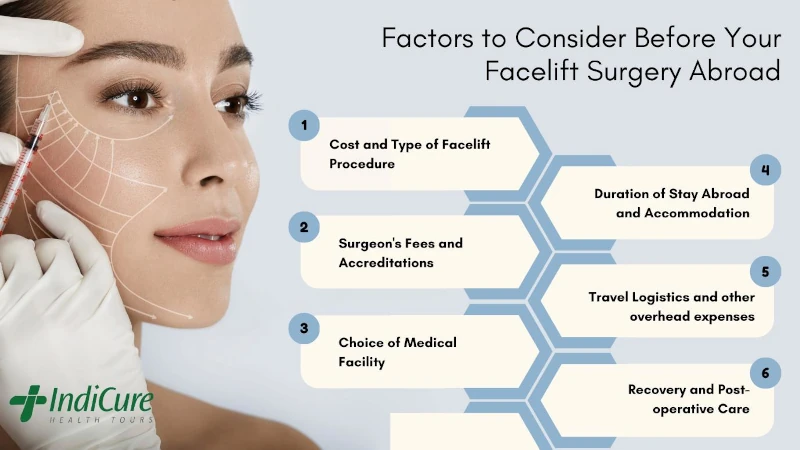Your Comprehensive Guide to a Successful Facelift Surgery Abroad in India

Feeling stuck between wanting a facelift surgery but you keep finding either unaffordable local options or those that do not meet quality standards? Pack your bags and travel to a medical tourism destination where you get good quality facelift surgery at affordable costs.
However, planning a facelift surgery abroad requires meticulous forethought, thorough research, and careful consideration to ensure a safe and successful experience, more so when intending to get a facelift done in an unknown country.
Here is a comprehensive guide to help you plan for your facelift surgery abroad:
-
Know the Procedure Well
Being well informed of what you are venturing in, always makes navigation easier. And when it is something as important as your face, it is always a good idea to understand the procedure well to make an informed decision.
Facelift, medically known as Rhytidectomy, is a surgical procedure designed to rejuvenate the appearance of the face by addressing sagging skin, deep creases, and other signs of aging.
As we age, there are significant changes in the appearance of the face due to deflation, descent, and deterioration. There is loss of facial muscle tone, loss of skin elasticity and firmness, and often loss of the underlying fat.
In addition, there are signs of actinic (sun-related) injury, which may be in the form of pigmentary changes or fine wrinkles, sunspots, etc. The features of aging usually start setting in after the age of 40. This is however dependent on racial and geographical factors. Moreover, factors like stress, smoking, nutritional deficiencies, and other medical conditions may fast-track this process in certain individuals. Sagging, bulges, and folds around the eyes can make the eyes look old and tired. Descent of the tissues of the cheeks make the smile lines, that is, the nasolabial and melolabial (near the angles of the mouth) folds more prominent, reducing the definition of the jawline and causing the appearance of jowls.
- Types of Facelifts: Facelift procedures can vary based on the specific techniques used and the areas targeted for rejuvenation.
A traditional facelift involves a skin incision extending from the hairline on the side of the head, behind the sideburns downwards just in front of the ear, curving around the earlobe behind the ear, and ending in the posterior hairline. Most of this incision lies hidden within natural skin folds. Once the skin is lifted, the underlying tissues of the face and neck (known as the SMAS layer) are pulled upwards and obliquely and fixed. Any excess may be cut or suspended with surgical threads. The skin is then re-draped, excess skin trimmed off, and meticulously stitched without tension.
There are variations to traditional facelifts like Short Scar Facelift techniques, which cater to younger individuals or those with early changes of aging- who have less laxity in the cheeks and jawline, and none in the neck. In these cases, the incision is limited to only the front of the ear.
All techniques involve some form of attention to the SMAS layer. Extensive sub-SMAS dissection, SMAS plication, lateral SMASectomy, and Minimal Access Cranial Suspension (MACS) are all varieties of the procedure.
MACS Facelift is one technique where relatively less skin is undermined, and no direct dissection under the SMAS layer is done. The recovery time is shorter. Some patients may need a separate incision under the chin to address the platysma bands and modify them to correct the appearance of a turkey neck.
-
Who is the right candidate for facelift surgery?
Anyone who is highly motivated to look more youthful and rejuvenated and has realistic expectations can undergo Facelift surgery. Age is not a bar to undergo the surgery. While assessing patients, surgeons evaluate signs of aging, their severity, and other medical conditions and suggest a surgical procedure accordingly, to meet the individual's expectations and give a rejuvenated appearance.
There are also several non-surgical modalities currently available which may be alternatives to a surgical facelift but without the same durability or striking results. Except for younger patients with early changes of aging and those who do not want to undergo surgery, these are better as adjuncts to the surgery and not a replacement. There are some additional procedures like fat grafting, upper and lower blepharoplasty, Brow lift, etc. which further improve the final outcome of the surgery, giving an overall rejuvenation to the face.
-
Where to travel for facelift surgery?
When you are on a budget, traveling abroad for facelift surgery is an obvious choice, but a critical question is which country do you travel to?
A cursory search over the internet would spring up some popular medical tourism destination names like South Korea, Thailand, India, Mexico, Brazil etc. While considering any of these destinations, it is essential to thoroughly research the qualifications of the surgeons and the accreditation of the facilities to ensure a safe and successful procedure.
To decide among these medical tourism destinations, one must look for a combination of advanced medical facilities, experienced surgeons, attractive tourism opportunities, and overall cost considerations.
One medical tourism destination that wields an irresistible blend of all these considerations is India. Facelift surgery in India stands out with its exceptional blend of quality medical infrastructure, highly experienced surgeons, and one of the most competitive prices. Indian surgeons are globally recognized for their expertise and proficiency, making India a preferred choice for many seeking cosmetic surgery procedures.
-
Prepare financially and mentally
Once you have decided to embark on a journey for a facelift abroad, and have decided on the medical tourism destination for it, it is time to make specific preparations. You must consider factors such as duration of stay abroad, travel logistics, post-operative care, recovery accommodations, and overall cost of the surgery, stay, and other overhead expenses. Preparing yourself mentally and financially for this surgery trip abroad is the key to smooth sailing and goes a long way in avoiding any unpleasant surprises.

-
Cost of facelift surgery abroad:
While the medical aspects are crucial, the financial aspects of Facelift surgery abroad are equally important, as they can determine whether you can proceed with your plans.
The cost of Facelift surgery in India is almost a quarter to one-third as compared to the cost of facelift surgery in the USA, Canada, UK, Australia, New Zealand, etc., and that too without any compromise on the quality of surgery. India boasts world-class medical facilities equipped with state-of-the-art technology and internationally accredited hospitals that provide high-quality healthcare services at many affordable prices, thus making it a preferred destination for Facelift surgery abroad.
-
Time required for facelift surgery in India
-
Pre-operative Protocol: Safety is cardinal while undergoing any surgery, so a strict protocol must be followed for patient safety. The patient must be deemed fit for undergoing Facelift surgery, for which blood and other investigations like ECG, X-RAY chest, and 2 D ECHO are performed to rule out any medical problems. All these pre-operative checkups may take a day or two to complete.
Previous allergic reactions to drugs, intake of blood thinners, and herbal medicines are important aspects of drug history that need to be taken before surgery. To stop smoking for a minimum of 2 weeks before the procedure is an important requirement. Also, in patients who have a long history of smoking, surgery is at high risk for complications like bleeding, hematomas, and delayed healing. It is equally important to control blood pressure at least 5 days before surgery, to avoid any major complications.
Blood thinners can only be restarted after 5-7 days. Resumption of smoking can lead to potentially serious complications and is best avoided for several weeks.
-
Post-operative care: It is generally advisable for patients to stay at the hospital for 1-2 days post-surgery. This is to make sure that they get 24*7 nursing care and complete medical supervision. This is more important while you are alone and may not have someone to take care of you for your facelift surgery abroad.
Blood pressure monitoring and good pain control are important things to take care of, in the post-operative period. Head high position and pressure garment help to reduce swelling and aid early recovery. Regular day-to-day activities can be resumed after 1-2 days. Medications to reduce swelling, antibiotics, and anti-inflammatory drugs are generally prescribed.
One can choose to stay at a nearby hotel/ guest house during this time, which can be pre-booked.
Follow-up is usually on the 4th post-operation day to check the status of skin flaps and on the 7th day for removal of the stitches. Blood thinners and other medicines can be started after 7 days of the facelift surgery. The pressure garment must be worn for at least 6-8 weeks to get desired results.
-
Recovery time: Recovery time after Facelift surgery usually lasts for 2-3 weeks. A good facial compression garment helps to hold the tissue in place and prevent any minor bleeding. Depending on the additional procedures performed, bruising resolves after a week to 10 days and patients can resume work/ social life. Occasionally there may be prolonged bruising in some cases. Scars continuously improve with time and are nearly invisible after 6 months to a year.
-
-
Possible Complications:
Despite rigorous and meticulous planning and following extensive pre/ post-operative protocols, complications can occur.
Bleeding within the tissues or hematoma (blood clots under the skin) is the most common complication seen with facelift surgeries. It could be a minor bleeding that can be treated conservatively, or a major one- usually apparent within 24-48 hours of surgery, which may require emergency surgery for removal of the clot. Hematomas are commonly related to uncontrolled blood pressure or blood thinners.
Skin flap necrosis (blackening) may occur following a hematoma or excessive tension on the skin while taking stitches. The most common site is behind the ear but it may also occur in front of the ear. Smoking is a major risk factor for this complication. The treatment is usually by regular dressings, till healing takes place.
Numbness over the face and neck is expected after facelift surgery, is usually temporary, and recovers over a few weeks.
In conclusion, by careful planning and preparing for your facelift surgery abroad, you can maximize the likelihood of a safe and successful surgery. A thorough research, clear communication, and collaboration with trusted healthcare professionals can go a long way in helping you achieve your dream.
IndiCure helps you plan and execute facelift surgery abroad in India
IndiCure Health Tours specializes in arranging end-to-end cosmetic surgery tourism abroad to India. We conduct extensive research about plastic surgeons and choose to associate only with the best plastic surgeons in India. As a medical traveler who is seeking a facelift surgery abroad, you can count on this research and connect with the IndiCure-recommended surgeons with the confidence and surety of being in safe hands.
As an end-to-end medical tour facilitator in India, IndiCure Health Tours will pre-plan your surgery trip and ensure seamless execution of the plan when you are in India for your facelift surgery.
To get your candidature evaluated by IndiCure's best plastic surgeons in India, get in touch with them by writing an email to info@indicure.com or sending a WhatsApp text to +919320036777.